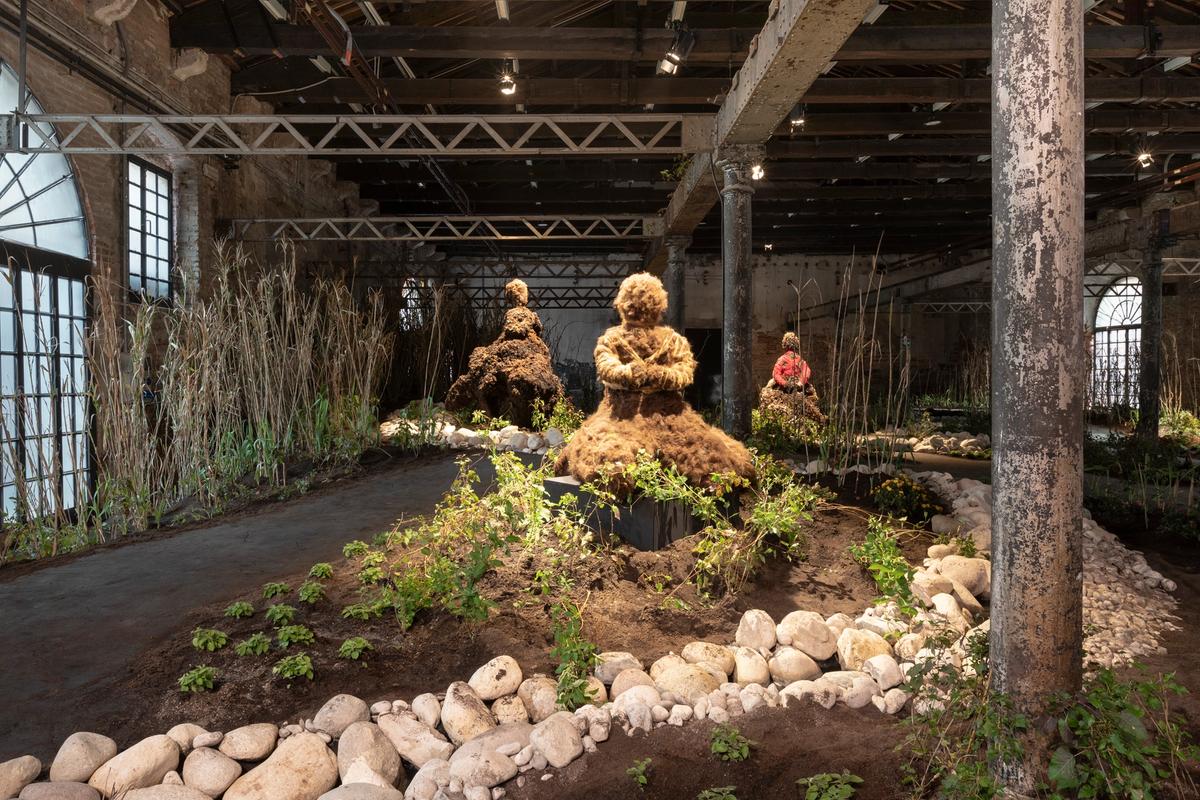“Let’s change the history of the future.” So says a cyborg to her human avatar in Lynn Hershman Leeson’s Logic Paralyzes the Heart (2021). The video is one of a cluster of works by the digital art pioneer close to the end of Venice’s Arsenale, as The Milk of Dreams—Cecilia Alemani’s rich and often thrilling Biennale show—reaches its conclusion. It is a time-warping exhibition, where temporal states are uncertain, in flux; a material for artists to shape and manipulate, as they do with everything from crystal to coffee, bottles and bedsprings, porcelain and paint—lots of paint—in the show.
It is also profoundly topical; while activism and protest are not dominant, it is unequivocally concerned with the Anthropocene and its effects. It confronts, among much else, the idea that we must imagine a post-anthropocentric and even post-human future, and ponders the attitudes and behaviours that have led us to where we are—many of the artists Alemani has chosen are doing so in extraordinarily imaginative ways. It is deeply connected to speculative fiction in this sense, with the writers Ursula Le Guin and Octavia Butler as looming presences.
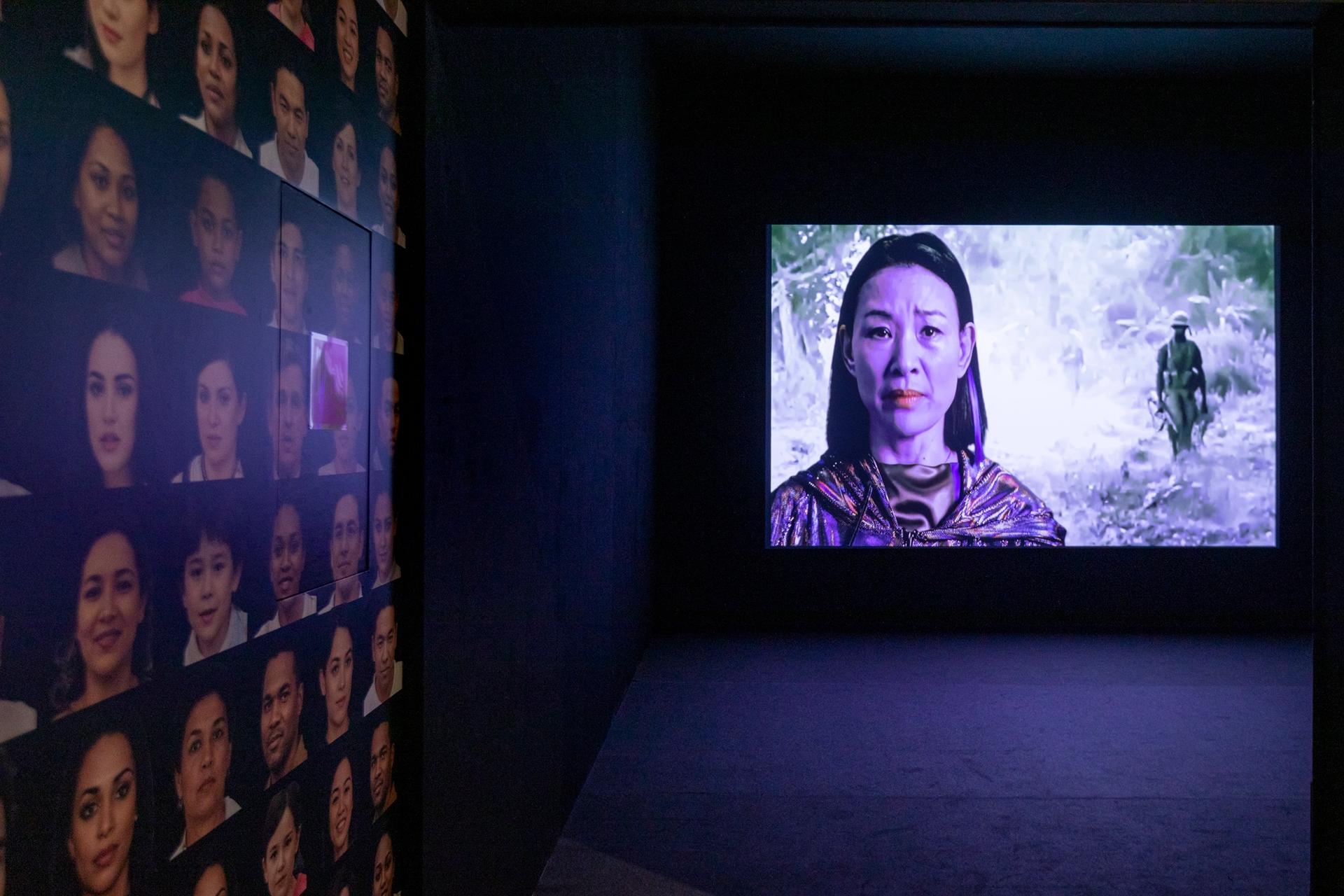
Lynn Hershman Leeson's Logic Paralyzes the Heart (2021) Photo: Roberto Marossi; Courtesy of La Biennale di Venezia
In Hershman Leeson’s video her cyborg illuminates the history of artificial intelligence, from Alan Turing’s Enigma machine, to the first coining of the term cyborg (61 years before the film was made), through its use in military technologies, in partnerships between corporations and security agencies, and in the horrors of predictive policing. It reveals how AI algorithms often exploit the most vulnerable in society.
The cyborg is an example of another key element of Alemani’s thesis: the hybrid body, whether that be human-animal, human-plant or, in this case, human-machine. Hershman Leeson is characteristically knowing and critical. To make her point, the cyborg says that, despite being “bodiless programmable code”, she’s taken a human form because “humans rarely hear or see anything that doesn’t look like them”—perhaps the fundamental cause of our present ecological crisis. Also at the heart of that malaise is the void between algorithms’ logic, their basis in rationality, and human feelings and imagination. It’s a plea for technologies and humans to cohabit, to adopt a more empathetic balance. Hence Hershman Leeson’s title, Logic Paralyses the Heart, and the cyborg’s request to her avatar—and by extension to us, her audience—that we teach her how to dream.
Capsule collections
Hybrid bodies, critiques of the rational and surrendering to the world of dreams are all, of course, at the heart of the Surrealist imagination. In taking the title for her show from Leonora Carrington’s children’s story, Alemani made the link to the 20th-century movement explicit from the start. In The Witch’s Cradle, the first of five historic “time capsules” which act as seedbeds for the contemporary works in the surrounding rooms—three in the Giardini, two in the Arsenale—she brings together women Surrealists, those who shared some of the movement’s ideas but operated outside it, and others whose work corresponds visually with them.
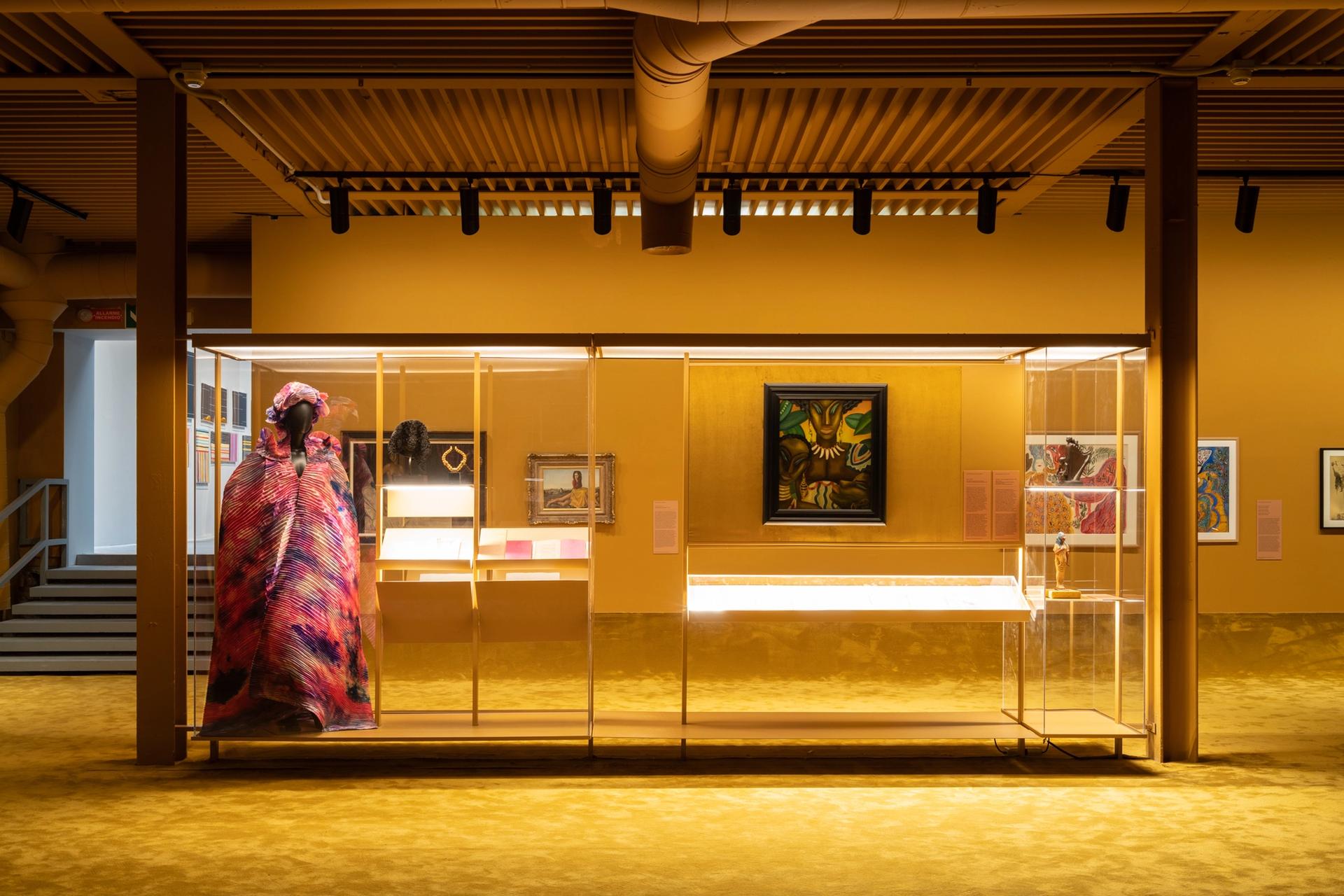
Capsule one: The Witch’s Cradle Photo: Marco Cappelletti; Courtesy of La Biennale di Venezia
It’s important that all the Surrealist artists here are women—indeed, the time capsules are exclusively the preserve of female artists—because Alemani highlights that in the reimagined bodies, fluid identities and critiques of authority they depict, there is often a break, too, with heteronormativity, something that is rarer among male Surrealists. In this, the women are more in tune with the contemporary art beyond the capsule. As the art historian Alyce Mahon puts it in the catalogue, women Surrealists “aimed to re-educate through re-enchantment”, often adopting and reimagining the forms and narratives of fairy tales. There are marvellous things in this vein by Remedios Varo, Toyen, Dorothea Tanning and Leonor Fini—although it’s a minor pity that there are none of Fini’s paintings where she imagines herself as a sphinx-human hybrid.
Alemani has said that she was grateful at the height of the pandemic for the pauses from Zoom calls with artists to plunge into research for the time capsules and it shows—there is a delight in the historic material, and in teasing out connections, rhymes and correspondence. There is too much in the capsules to go into detail about all five—the others are, crudely: text and the body, technology and selfhood, the vessel and the cyborg. But they are each brilliantly judged in content and placing, and vital in introducing not just themes, artist-touchstones and historic movements, but the visual languages and materials that echo and resonate abundantly in the rooms beyond.
The capsules are designed by Studio Formafantasma, and are given bespoke architectural structures, materials and colours that separate them from the rest of the show—The Witch’s Cradle is a deep ochre in colour, carpeted and dimly lit with spotlights on the works, many of which are in vitrines. The capsules are effectively mini-museums dotted through the show—one can imagine them travelling as exhibitions to institutions in the future. And they are tremendously effective, too, in changing the pace of the show, renewing our modes of looking, keeping at bay (at least for longer) the fatigue that biennials can so often prompt.
Space and pace
Indeed, the pacing of the show as a whole is largely exemplary. Alemani begins both the Giardini and the Arsenale with big set-pieces. Katharina Fritsch’s Elephant (1987) stands alone, majestic but unsettling in its deep greenness, surrounded by mirrors in which a spectral herd is created. The significance of the elephant is manifold: a matriarchal animal, it is an emblem of a Biennale dominated by women artists; the simple act of casting it in that chromium oxide green shifts its presence from realism to the uncanny, to the territory of fairy tales. In bringing Fritsch’s 35-year-old work into a new context, Alemani creates additional significance: an elephant called Toni once occupied this very location in the city—it was known as “the prisoner of the Giardini”.
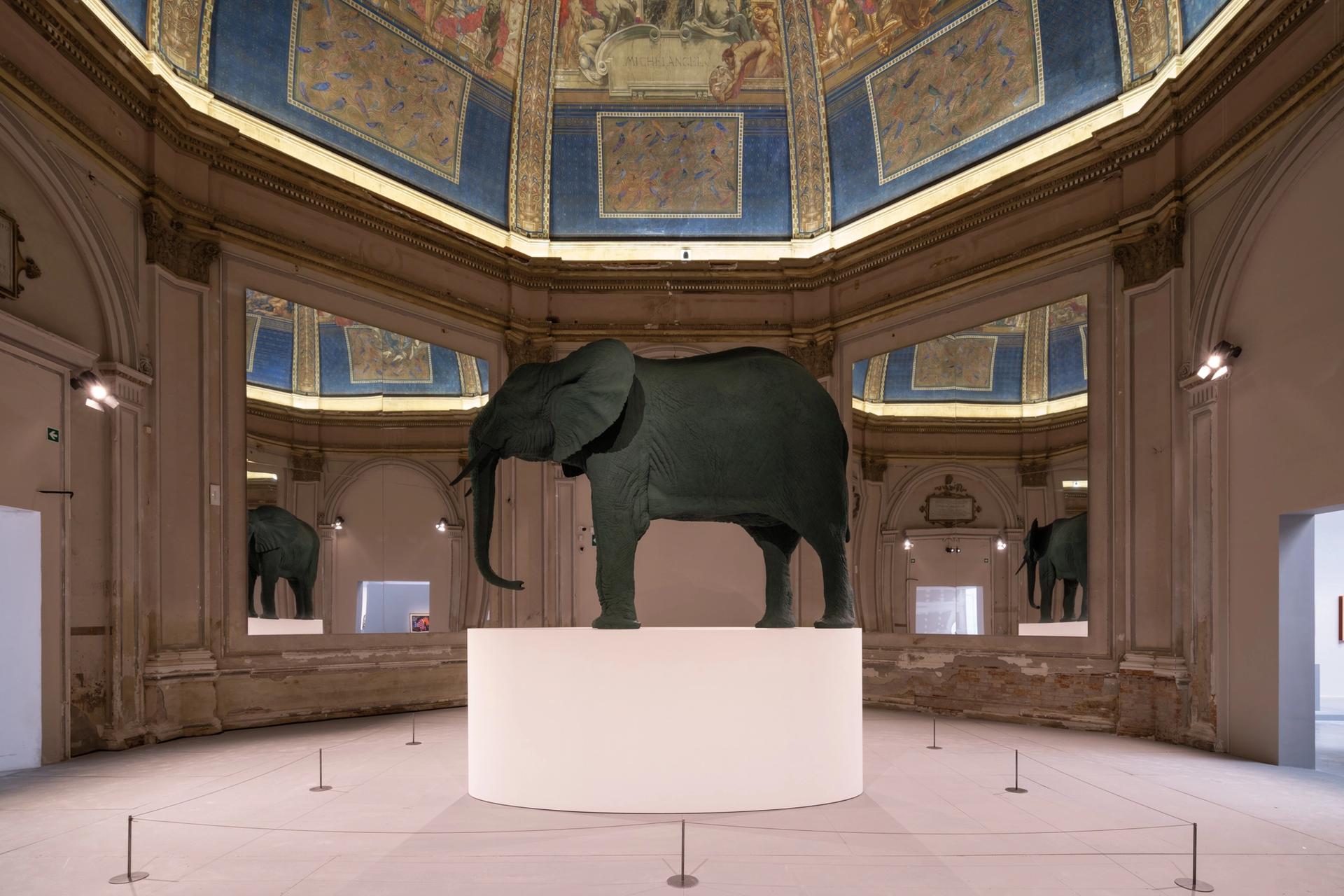
Katharina Fritsch’s Elephant (1987) Photo: Marco Cappelletti; Courtesy of La Biennale di Venezia
Opening the Arsenale is Simone Leigh’s Brick House (2019), originally commissioned by Alemani in her day job as the curator of the High Line in New York. Here, inside the Corderie—the vast industrial building once used for the Venetian armada’s rope-making—its power might even be enhanced. It towers over us, mute, eyeless, yet redolent with the multiple meanings of Leigh’s Anatomy of Architecture series. Most apt for Alemani’s show, of course, is its hybridity—it is a Black woman’s body and also a building, and it draws, too, on historic knowledge, including that of the Batammaliba people of Northeast Togo, whose architecture is given personhood. This current of disparate belief systems and customs, often ancient and Indigenous, charges much of the Biennale.
Among the most dramatic examples is in Delcy Morelos’s Earthly Paradise (2022), a maze of waist-high earth immediately conjuring Walter de Maria’s classic Land Art piece in New York, Earth Room (1977). But it is invested with meanings associated with Morelos’s background in the Emberá-Catio people of Tierralta in Colombia. Take your mask off (currently an enforced Covid requirement), and you smell spices in the earth, from cloves, cinnamon and cacao powder. As in her ceramic works, Morelos imbues the earth with potency, it becomes a living entity that we can’t help but interact with, through the aroma and our negotiation of the structure she creates. It manages to be both vivifying and elegiac: earth produces life but our ultimate fate is to return to it.
Alemani punctuates the Arsenale, a notoriously difficult space to tackle, with numerous installations that act as architectural structures. Emma Talbot’s hanging curtain arcs around two of the Corderie’s pillars, featuring a teeming tableau of figures and handwritten text alluding to the climate emergency and its anthropocentric causes: “Why do we think we can outwit nature?”, she asks. It’s an extraordinary piece, reminiscent of William Blake at his most elemental and visionary, and full of foreboding and anxiety.
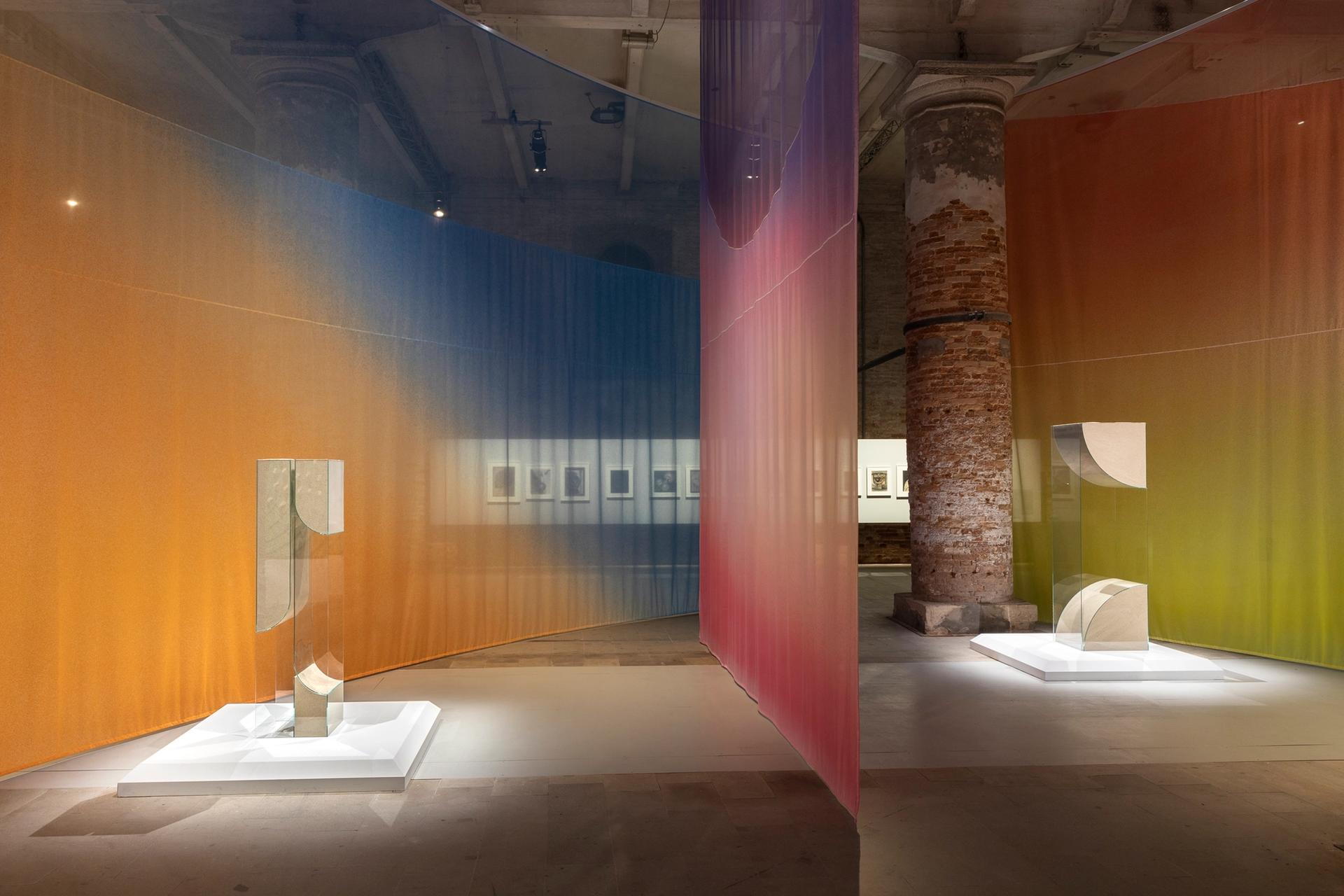
Kapwani Kiwanga's series of fabrice works Sunset Horizon (2022) and Hour glass series (2022) Photo: Roberto Marossi; Courtesy of La Biennale di Venezia
The Chilean artist Sandra Vásquez de la Horra and Canadian Kapwani Kiwanga also create notable interruptions in the space. Vásquez de la Horra’s custom-built wooden structure is filled with her drawings, including folded objects featuring bodies that double as mountain ranges (again, Indigenous knowledges are an influence). Kiwanga has created floor-to-ceiling paintings on diaphanous fabric, each called Sunset Horizon (2022) and evoking luminous desert skies, alongside enigmatic geometric glass sculptures filled with sand that is a by-product of fracking. The glass pieces are called Hour glass (2022) and seem immovable, suggesting that time has run out, and while the fabric paintings might be beautiful they have a similarly grave symbolism for a heating planet at the mercy of extractive practices.
Making connections
Perhaps the most dramatic installation anywhere in Alemani’s show, also rich with symbolism, is Precious Okoyomon’s To See the Earth Before the End of the World (2022). In a room all to itself, and within a booming abstract soundtrack, it is a landscape occupied by black water pools, stones, pathways and plants—most notably, sugar cane and kudzu. The latter is a Japanese plant originally brought to the US to revitalise soil whose nutrients had been sapped through the over-production of cotton. But it took over, and became devastatingly invasive—over the course of the Biennale, Okoyomon’s kudzu will also grow uncontrollably, and reclaim the installation for itself.
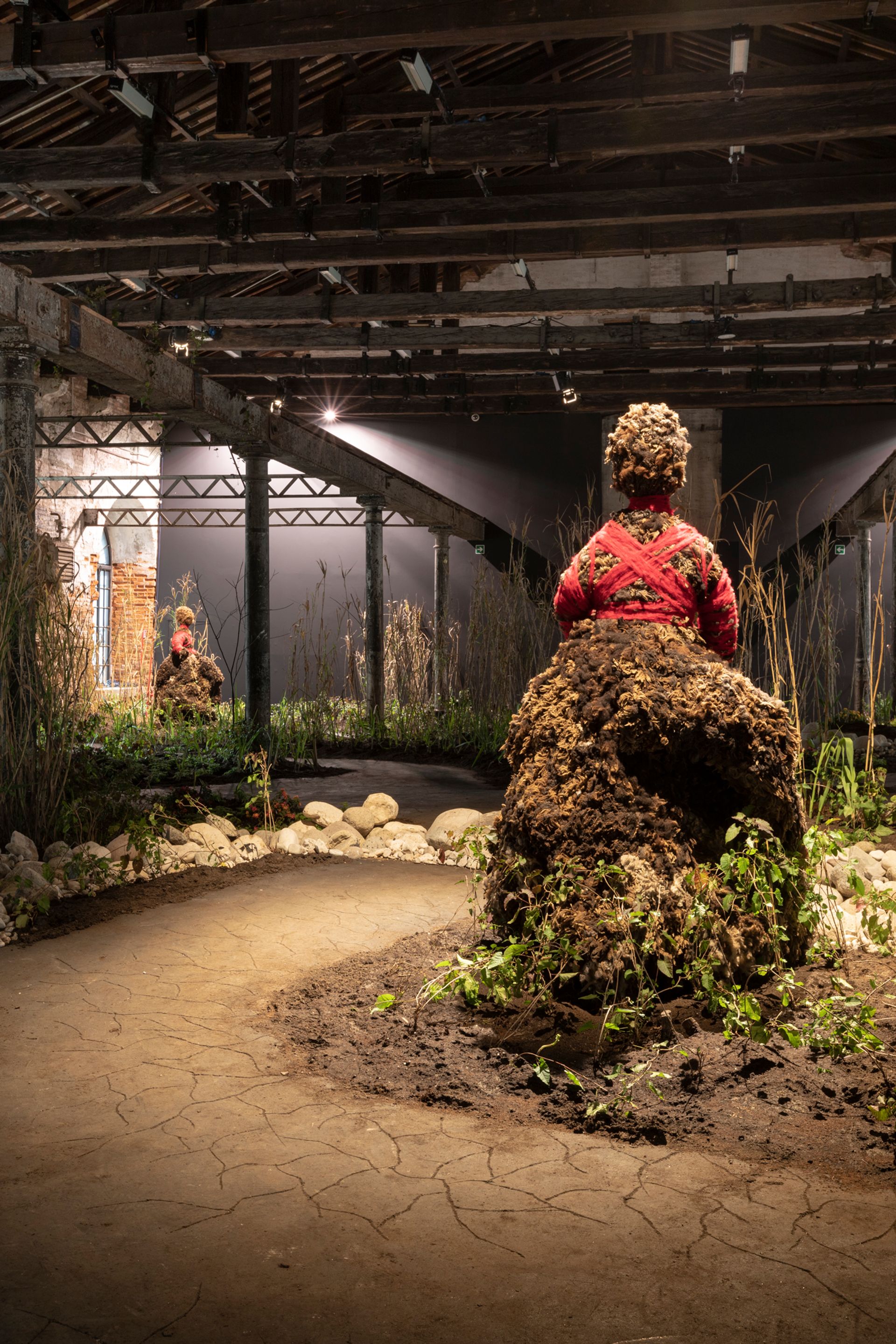
Precious Okoyomon’s To See the Earth Before the End of the World (2022). Photo: Roberto Marossi; Courtesy of La Biennale di Venezia
Of course, both the sugar cane and the kudzu are vegetal metaphors for humans: enslaved peoples, displaced peoples, and their deep connection with land and landscape. Appearing to rise from the plant beds are life-size figures in raw wool, yarn and blood and dirt, calling to mind ancient sculptures. As much as it is a meditation on past horrors, Okoyomon’s landscape is a site of potential, as they see it. Note that their title says before the end of the world; with that in mind, their totemic figures adopt a certain revolutionary power.
Beyond sculptural installation, I think Alemani was right to include a relatively small but largely judicious selection of video works. Ali Cherri’s Of Men and Gods and Mud (2022) is a three-screen installation in the Arsenale, with documentary footage of brick-making in Sudan and a narration that conjures myths and the inextricable connection between the earth, people and belief systems. Nan Goldin’s Sirens (2019-20) is the pick of the videos in the Giardini—Goldin reflects on the story of Donyale Luna, the Black model and actress who died young of a heroin overdose, through a delirious yet mournful mashup of found footage of Luna and other dreamily intoxicated figures.

Mrinalini Mukherjee's hemp figures Photo: Marco Cappelletti; Courtesy of La Biennale di Venezia
Alemani shows a profound understanding of the limits and possibilities of her two sites: the Arsenale more polyphonic between big set-pieces and the Giardini as the zone for stimulating pairings and trios. The late Indian artist Mrininalini Mukherjee’s hemp figures, the post-Surrealist paintings and flotsam-and-jetsam sculptures by Cecilia Vicuña and the landscape-figure-microbiological paintings of Merikokeb Berhanu is one of many stand-out groupings. Another set brings together the ever-impressive morphing figurations of Christina Quarles, the tallon-and-membrane spookiness of Hannah Levy’s sculptures, and the hugely moving final works of Kaari Upson, who died last year. Her 3D modelled relief portraits (perhaps self-portraits?) are covered in fields of urethane, resins and pigments, so that the facial image either lurks behind the veils of colour or appears to retreat into nothingness.
Quietly, there is a survey across the Giardini of seriously playful painters of the same generation who seemed to unearth new depths in their medium, and continue to today—Amy Sillman, Charline von Heyl and Jacqueline Humphries all show hugely impressive works. Allison Katz, who was taught by both Sillman and Von Heyl, mines her own furrow with great humour, precision and mystery in five paintings (with knowing nods to Venetian themes) in the Arsenale.
The sheer coherence of Alemani’s show is evident in the way that the works talk to each other not just in the same room, or between the capsules and the contemporary spaces, but between the Giardini and Arsenale. It is a show of ripples and resonances, one that honours its artists by letting them dictate its paths, while providing a perfectly judged structure to allow their thoughts to percolate, and their imaginations to soar.


